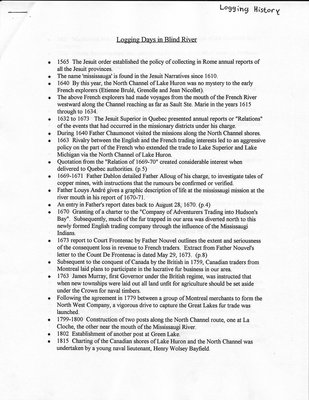Logging History
Logging Days in Blind River
• 1565 The Jesuit order established the policy of collecting in Rome annual reports of all the Jesuit provinces.
• The name 'mississauga' is found in the Jesuit Narratives since 1610.
• 1640 By this year, the North Channel of Lake Huron was no mystery to the early French explorers (Etienne Brule, Grenolle and Jean Nicollet).
•The above French explorers had made voyages from the mouth of the French River westward along the Channel reaching as far as Sault Ste. Marie in the years 1615 through to 1634.
• 1632 to 1673 The Jesuit Superior in Quebec presented annual reports or "Relations" of the events that had occurred in the missionary districts under his charge.
• During 1640 Father Chaumonot visited the missions along the North Channel shores.
• 1663 Rivalry between the English and the French trading interests led to an aggressive policy on the part of the French who extended the trade to Lake Superior and Lake Michigan via the North Channel of Lake Huron.
•Quotation from the "Relation of 1669-70" created considerable interest when delivered to Quebec authorities, (p. 5)
• 1669-1671 Father Dablon detailed Father Alloug of his charge, to investigate tales of copper mines, with instructions that the rumors be confirmed or verified.
•Father Louys Andre gives a graphic description of life at the mississaugi mission at the river mouth in his report of 1670-71.
• An entry in Father's report dates back to August 28, 1670. (p.4)
• 1670 Granting of a charter to the "Company of Adventurers Trading into Hudson's Bay". Subsequently, much of the fur trapped in our area was diverted north to this newly formed English trading company through the influence of the Mississaugi Indians.
• 1673 report to Court Frontenac by Father Nouvel outlines the extent and seriousness of the consequent loss in revenue to French traders. Extract from Father Nouvel's letter to the Count De Frontenac is dated May 29, 1673. (p.8)
• Subsequent to the conquest of Canada by the British in 1759, Canadian traders from Montreal laid plans to participate in the lucrative fur business in our area.
• 1763 James Murray, first Governor under the British regime, was instructed that when new townships were laid out all land unfit for agriculture should be set aside under the Crown for naval timbers.
• Following the agreement in 1779 between a group of Montreal merchants to form the North West Company, a vigorous drive to capture the Great Lakes fur trade was launched.
• 1799-1800 Construction of two posts along the North Channel route, one at La Cloche, the other near the mouth of the Mississaugi River.
• 1802 Establishment of another post at Green Lake.
• 1815 Charting of the Canadian shores of Lake Huron and the North Channel was undertaken by a young naval lieutenant, Henry Wolsey Bayfield.


